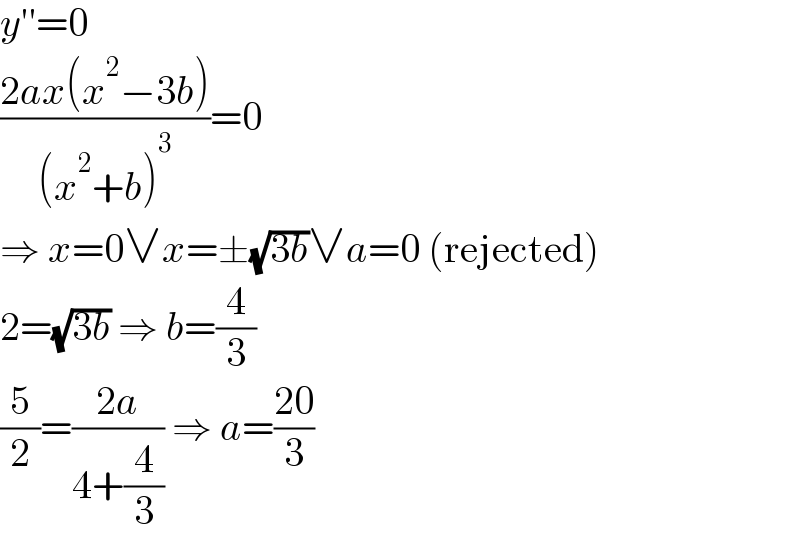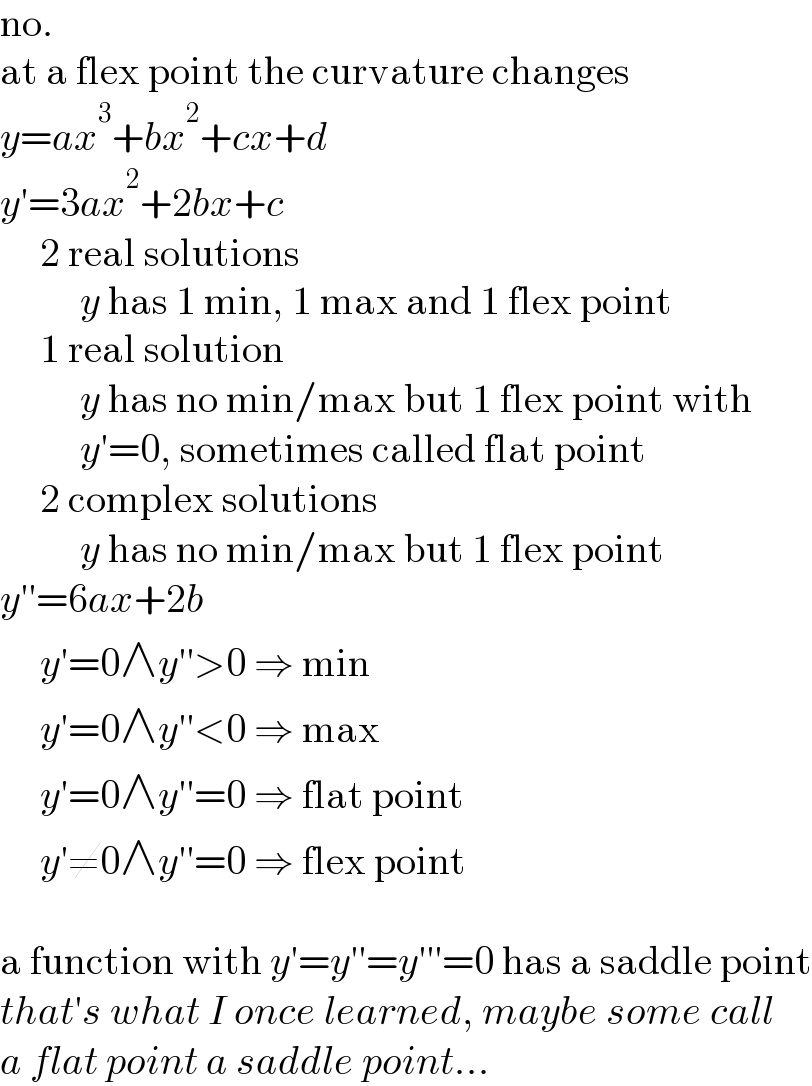
Question Number 153252 by liberty last updated on 06/Sep/21

Answered by MJS_new last updated on 06/Sep/21

$${y}''=\mathrm{0} \\ $$$$\frac{\mathrm{2}{ax}\left({x}^{\mathrm{2}} −\mathrm{3}{b}\right)}{\left({x}^{\mathrm{2}} +{b}\right)^{\mathrm{3}} }=\mathrm{0} \\ $$$$\Rightarrow\:{x}=\mathrm{0}\vee{x}=\pm\sqrt{\mathrm{3}{b}}\vee{a}=\mathrm{0}\:\left(\mathrm{rejected}\right) \\ $$$$\mathrm{2}=\sqrt{\mathrm{3}{b}}\:\Rightarrow\:{b}=\frac{\mathrm{4}}{\mathrm{3}} \\ $$$$\frac{\mathrm{5}}{\mathrm{2}}=\frac{\mathrm{2}{a}}{\mathrm{4}+\frac{\mathrm{4}}{\mathrm{3}}}\:\Rightarrow\:{a}=\frac{\mathrm{20}}{\mathrm{3}} \\ $$
Commented by liberty last updated on 06/Sep/21

$${thank}\:{you}.\:{i}\:{don}'{t}\:{understand} \\ $$$${a}\:{flex}\:{point}.\:{it}\:{is}\:{same}\:{to}\:{sadle} \\ $$$${point}\:{sir}? \\ $$
Commented by MJS_new last updated on 06/Sep/21

$$\mathrm{no}. \\ $$$$\mathrm{at}\:\mathrm{a}\:\mathrm{flex}\:\mathrm{point}\:\mathrm{the}\:\mathrm{curvature}\:\mathrm{changes} \\ $$$${y}={ax}^{\mathrm{3}} +{bx}^{\mathrm{2}} +{cx}+{d} \\ $$$${y}'=\mathrm{3}{ax}^{\mathrm{2}} +\mathrm{2}{bx}+{c} \\ $$$$\:\:\:\:\:\mathrm{2}\:\mathrm{real}\:\mathrm{solutions} \\ $$$$\:\:\:\:\:\:\:\:\:\:{y}\:\mathrm{has}\:\mathrm{1}\:\mathrm{min},\:\mathrm{1}\:\mathrm{max}\:\mathrm{and}\:\mathrm{1}\:\mathrm{flex}\:\mathrm{point} \\ $$$$\:\:\:\:\:\mathrm{1}\:\mathrm{real}\:\mathrm{solution} \\ $$$$\:\:\:\:\:\:\:\:\:\:{y}\:\mathrm{has}\:\mathrm{no}\:\mathrm{min}/\mathrm{max}\:\mathrm{but}\:\mathrm{1}\:\mathrm{flex}\:\mathrm{point}\:\mathrm{with} \\ $$$$\:\:\:\:\:\:\:\:\:\:{y}'=\mathrm{0},\:\mathrm{sometimes}\:\mathrm{called}\:\mathrm{flat}\:\mathrm{point} \\ $$$$\:\:\:\:\:\mathrm{2}\:\mathrm{complex}\:\mathrm{solutions} \\ $$$$\:\:\:\:\:\:\:\:\:\:{y}\:\mathrm{has}\:\mathrm{no}\:\mathrm{min}/\mathrm{max}\:\mathrm{but}\:\mathrm{1}\:\mathrm{flex}\:\mathrm{point} \\ $$$${y}''=\mathrm{6}{ax}+\mathrm{2}{b} \\ $$$$\:\:\:\:\:{y}'=\mathrm{0}\wedge{y}''>\mathrm{0}\:\Rightarrow\:\mathrm{min} \\ $$$$\:\:\:\:\:{y}'=\mathrm{0}\wedge{y}''<\mathrm{0}\:\Rightarrow\:\mathrm{max} \\ $$$$\:\:\:\:\:{y}'=\mathrm{0}\wedge{y}''=\mathrm{0}\:\Rightarrow\:\mathrm{flat}\:\mathrm{point} \\ $$$$\:\:\:\:\:{y}'\neq\mathrm{0}\wedge{y}''=\mathrm{0}\:\Rightarrow\:\mathrm{flex}\:\mathrm{point} \\ $$$$ \\ $$$$\mathrm{a}\:\mathrm{function}\:\mathrm{with}\:{y}'={y}''={y}'''=\mathrm{0}\:\mathrm{has}\:\mathrm{a}\:\mathrm{saddle}\:\mathrm{point} \\ $$$${that}'{s}\:{what}\:{I}\:{once}\:{learned},\:{maybe}\:{some}\:{call} \\ $$$${a}\:{flat}\:{point}\:{a}\:{saddle}\:{point}... \\ $$
